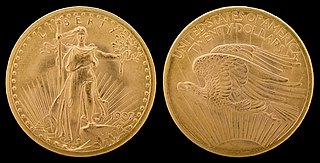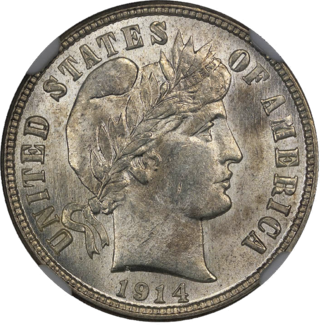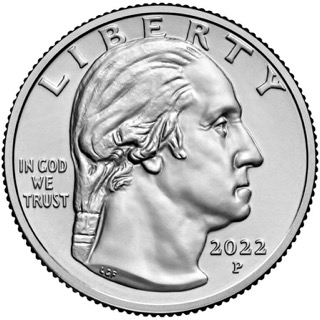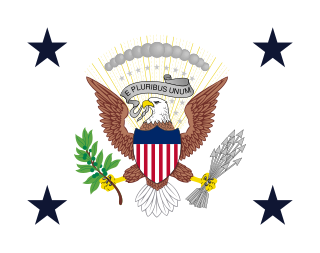This article provides a list of notable depictions of the Great Seal of the United States, excluding the official dies.
This article provides a list of notable depictions of the Great Seal of the United States, excluding the official dies.

In 1894 Palemon Howard Dorsett, a lifelong Department of Agriculture employee, turned up at the Department of State with a metal die engraved with the Great Seal, claiming it had originally been given to his family by a nephew of George Washington. It was examined by Gaillard Hunt, the author of a pamphlet on the Great Seal, who agreed that it appeared to be contemporaneous with the original 1782 seal, but he took no further interest in the matter. [1]
Decades later, in 1936, Dorsett wrote again regarding his die, and this time it was investigated more thoroughly. It is a very similar design to the first Great Seal die and obviously copied from it, even including a border of acanthus leaves. The eagle was different though, being more spirited with its wings more widely spread. More significantly, the arrows and the olive branch are switched, indicating an intentional "difference" to distinguish it from the actual Great Seal. It is the same size as the first die, and is made of bronze. There was no indication that it could actually be used in a seal press, and a search of government documents showed no use of the seal anywhere. [2]
The investigation also turned up some facts that supported Dorsett's story: documents relating to the sale of Washington's estate list "plates arms U.S." being sold to Thomas Hammond (a son-in-law of Charles Washington and therefore a nephew by marriage to George Washington), and also the Hammond and Dorsett families both had roots in West Virginia just a few miles apart. Afterwards Dorsett lent his seal to Mount Vernon, and his heirs made it a donation. It was eventually put on display in a museum there. [2]
The origins and purpose of this die remain unknown. Both Hunt and the authors of Eagle and the Shield speculate it was meant to be used by either the President of the Congress or later by the President of the United States, but there is no other evidence to support this. [1] In October and November 2007, two more dies were discovered in Rhode Island with exactly the same design (though cut in relief), even down to the same small flaws. They were made of silver-plated lead, which is sometimes used as an engraving test since it is a cheaper metal. [1]
In 1786, for the first two issues of Columbian Magazine , Philadelphia engraver James Trenchard wrote articles on the obverse (in September 1786) and reverse (in October 1786) of the Great Seal, and each issue included a full-page engraving of his own original version of the discussed side of the seal. The project apparently was aided by William Barton, as the official law was printed along with supplemental notes from Barton. Trenchard's obverse featured randomly placed stars, like Thomson's drawing, and had the rays of the glory extending beyond the clouds upward, with the clouds themselves being in an arc. The reverse also followed the blazon carefully, and featured an elongated pyramid with the requisite mottos and the Eye of Providence (a right eye, unlike versions that followed). While not official, Trenchard's depiction had an obvious influence on subsequent official versions, and was the first known public rendering of the reverse side (and only one for many years). [3] [4]

St. Paul's Chapel in New York City has a large oil painting of the national coat of arms, believed installed sometime in 1786. It was commissioned on October 7, 1785, not long after the Congress of the Confederation began meeting in nearby Federal Hall. The painting hangs over Washington's pew, across the room from a painting of the arms of New York over the Governor's pew. The painting has many similarities to Trenchard's version (or vice versa depending on which came first), including the random placement of stars and details of the eagle. The clouds are in a full circle, though, instead of an arc, and the rays extend beyond them in all directions. The shield has a gold chain border with a badge at the bottom. This is the earliest known full-color version of the seal design, and the artist is unknown. [4] [5]
European powers had traditionally given "peace medals" to Native American Indians in an attempt to curry favor, and the newly created United States followed suit. On April 28, 1786, the Congress authorized creation of Indian Peace Medals with the coat of arms (obverse of the Great Seal) on one side, and various designs on the other. The medals were typically oval and made of silver, and were fairly large. [4] The use of the arms on these medals continued through 1795, with the more famous ones having a scene with George Washington on the other side. [6] Medals made after this time used other designs, and the practice continued through the administration of Benjamin Harrison.
The design of the arms on these medals, made by the U.S. Mint, follow the Trenchard design very closely. The stars are randomly placed, the clouds form an arc, with the rays of the glory upward and outwards, a design reminiscent of the modern-day seal of the president of the United States. [4]

In 1790 it was decided to award diplomatic medals to foreign envoys at the end of their service, as a less-extravagant version of the European custom to give diplomats expensive gifts upon their departure. Thomas Jefferson (then the Secretary of State) instructed the U.S. chargé d'affaires in Paris (William Short) to contract with a local engraver to make the medals, since the first was to go to the Marquis de la Luzerne, the former French minister. Jefferson specified that one side must be the Arms of the United States, and gave suggestions for the other side though left the final decision to Short and the engraving artist. Short chose Augustin Dupré, a leading engraver of the time, who completed the medals in 1792. [4]
Dupré created an elegant design, especially interesting for the position of the wings, which are more horizontal ("extended" in heraldic terms) than most other emblazonments. The eagle itself was unmistakably a bald eagle, without a crest. The five-pointed stars were arranged in a six-pointed star pattern (like the future 1841 die). The clouds are in an inverted arc, much like the official die, but the rays of the glory extend down beyond the clouds and in back of the eagle. Dupré added a UNITED STATES OF AMERICA legend around the sides, and a small rosette of leaves in the exergue below the eagle. For the reverse, Dupré apparently followed one of Jefferson's suggestions, depicting a scene of international commerce portrayed as Mercury (the god of diplomacy) in conference with the genius of America (shown as an Indian chief, similar to some early American copper coins). [6]
Only two medals (both made of gold) were given before the practice was terminated, one posthumously to de la Luzerne and the other to his successor Count de Moustier. Six bronze versions were also delivered to William Short. Their existence was eventually forgotten until the 1870s, when references to the medals in Jefferson's papers were connected to the discovery of Dupré's lead working model. [6] [4]

At the Freedom Plaza in Northwest Washington, D.C., there is a monument to the Great Seal of the United States. This includes a plaque of the seal, [7] followed by an inscription that reads:
In 1776 the continental congress adopted a resolution calling for the creation of a seal for the new nation. In June 1782 the United States Congress approved a design which was manufactured in September of that year. In early 1881 the Department of State selected a new design for the obverse, which was made in 1885. 2,000 to 3,000 times a year the seal is used on treaties and other international agreements; proclamations, and commissions of ambassadors, foreign service officers, and all other civil officers appointed by the President. In addition we see the seal design every day on the back of the one dollar bill.
This inscription honors both the history, and the modern functionality of the Great Seal, especially in regards to its use by the Department of State.
The Coinage Act of 1792 established the U.S. Mint and created the U.S. system of currency, and most of its rules were followed for many years. Among them was a basic design for any gold or silver coins; the obverse was required to have an "impression emblematic of liberty", with the reverse having a "figure or representation of an eagle". While using a depiction of the national arms was not necessary, various different arms designs were often used until the early 1900s, and still sometimes appear today on commemorative coins. Even before the mint, the 1787 Brasher Doubloon had a depiction of the arms on one side.

According to Henry A. Wallace (then the Secretary of Agriculture in President Franklin D. Roosevelt's cabinet), in 1934 he saw a 1909 pamphlet on the Great Seal by Gaillard Hunt. The pamphlet included a full-color copy of the reverse of the Great Seal, which Wallace had never seen. He especially liked the motto Novus Ordo Seclorum ("New Order of the Ages"), likening it to Roosevelt's New Deal (i.e., "New Deal of the Ages"). He suggested to Roosevelt that a coin be made which included the reverse, but Roosevelt instead decided to put it on the dollar bill. The initial design of the bill had the obverse on the left and the reverse on the right, but Roosevelt ordered them to be switched around. [3] [8] The first bill to contain both sides of the seal was the series 1935 $1 silver certificate. [9]
The obverse had originally appeared on the back of the $20 gold certificate, Series 1905. [9] In 2008, the redesigned front side of the five-dollar bill added a purple outline of the obverse of the Great Seal as a background, as part of freedom-related symbols being added to redesigned bills. [10]

When the U.S. government moved back to Philadelphia in 1790, the city, in an attempt to convince the federal government not to move to Washington, was determined to provide luxurious accommodations at Congress Hall, the recently constructed building where Congress was to meet. One of the finishing touches was in June 1791, when a large Axminster carpet was installed in the Senate's upper-floor chamber. The central design was the U.S. coat of arms, complete with the constellation of 13 stars, surrounded by the linked shields of all thirteen states. Under the arms, there was also a pole with a liberty cap and a balance of justice. The carpet was 22 by 40 feet, and was made by William Peter Sprague, an Englishman from Axminster (probably trained under Thomas Whitty) who had set up a factory in Philadelphia. The carpet was not brought to Washington, D.C., when the government moved in 1800, and is long lost. The National Park Service had a reproduction made in 1978 as part of the restoration of Congress Hall; they had to speculate on the exact design of the eagle and chose the representation seen on the first seal die. [11]

In the July 1856 Harper's New Monthly Magazine , historian Benson John Lossing wrote an article on the Great Seal. To illustrate the article, along with copies of Hopkinson's and Barton's original drawings and his own interpretations of the first committee's designs, he also included an apparently original version of the reverse. This depiction more resembles the Egyptian pyramids, and changed the Eye of Providence to a left eye. Lossing's reverse has heavily influenced all future renditions, including today's official version. [3]
In February 1882, C. A. L. Totten (then a 1st lieutenant in the U.S. Army) wrote to both the Secretaries of State and Treasury to suggest some sort of commemoration for the Great Seal, which was to have its centennial later that year, in particular including a version of the never-cut and rarely seen reverse side. The State Department demurred, but the Treasury Department (having the ability to act without express permission of Congress) decided that a commemorative medal would be appropriate and agreed to make one later that year. [6] [12]
The medal was designed by Charles E. Barber, the chief engraver of the U.S. Mint. For the obverse, Barber primarily used Trenchard's 1786 Columbian Magazine version, but replaced the eagle with the superior one from Dupré's 1792 Diplomatic Medal (which had been rediscovered a few years before). For the reverse, Barber directly copied Trenchard's 1786 design. According to Totten, two proofs were made in time for the June 20, 1882, centennial date with general circulation following in October 1882. This was the first time a design for the reverse had been officially issued by the U.S. government. [3] [6]
On August 4, 1945, a delegation from the Young Pioneer organization of the Soviet Union presented a carved wooden plaque of the Great Seal to U.S. Ambassador W. Averell Harriman, as a "gesture of friendship" to the USSR's allies of World War II. Concealed inside was a covert remote listening device called The Thing. It hung in the ambassador's Moscow residential study for seven years, until it was exposed in 1952 during the tenure of Ambassador George F. Kennan. [13] [14]

The Great Seal is a principal national symbol of the United States. The phrase is used both for the physical seal itself, which is kept by the United States secretary of state, and more generally for the design impressed upon it. The obverse of the Great Seal depicts the national coat of arms of the United States while the reverse features an unfinished pyramid topped by an Eye of Providence. The year of the U.S. Declaration of Independence, 1776, is noted in Roman numerals at the base of the pyramid. The seal contains three Latin phrases: E Pluribus Unum, Annuit cœptis, and Novus ordo seclorum.

E pluribus unum – Latin for "Out of many, one" – is a traditional motto of the United States, appearing on the Great Seal along with Annuit cœptis and Novus ordo seclorum which appear on the reverse of the Great Seal; its inclusion on the seal was approved in an act of the U.S. Congress in 1782. While its status as national motto was for many years unofficial, E pluribus unum was still considered the de facto motto of the United States from its early history. Eventually, the U.S. Congress passed an act in 1956, adopting "In God We Trust" as the official motto.

Annuit cœptis is one of two mottos on the reverse side of the Great Seal of the United States. The literal translation is "[He] favors [our] undertakings", from Latin annuo, and coeptum. Because of its context as a caption above the Eye of Providence, the standard translations are "Providence favors our undertakings" and "Providence has favored our undertakings".

The dime, in United States usage, is a ten-cent coin, one tenth of a United States dollar, labeled formally as "one dime". The denomination was first authorized by the Coinage Act of 1792.

The United States five-dollar bill ($5) is a denomination of United States currency. The current $5 bill features a portrait of Abraham Lincoln, the 16th U.S. president (1861-1865), on the front and the Lincoln Memorial on the back. All $5 bills issued today are Federal Reserve Notes.

The United States ten-dollar bill ($10) is a denomination of U.S. currency. The obverse of the bill features the portrait of Alexander Hamilton, who served as the first U.S. Secretary of the Treasury. The reverse features the U.S. Treasury Building. All $10 bills issued today are Federal Reserve Notes.

The United States one-hundred-dollar bill ($100) is a denomination of United States currency. The first United States Note with this value was issued in 1862 and the Federal Reserve Note version was launched in 1914, alongside other denominations. Statesman, inventor, diplomat, and American Founding Father Benjamin Franklin has been featured on the obverse of the bill since 1914. On the reverse of the banknote is an image of Independence Hall in Philadelphia, which has been used since 1928. The $100 bill is the largest denomination that has been printed and circulated since July 13, 1969, when the larger denominations of $500, $1,000, $5,000, and $10,000 were retired. As of December 2018, the average life of a $100 bill in circulation is 22.9 years before it is replaced due to wear.

The United States one-dollar bill (US$1), sometimes referred to as a single, has been the lowest value denomination of United States paper currency since the discontinuation of U.S. fractional currency notes in 1876. An image of the first U.S. president (1789–1797), George Washington, based on the Athenaeum Portrait, a 1796 painting by Gilbert Stuart, is currently featured on the obverse, and the Great Seal of the United States is featured on the reverse. The one-dollar bill has the oldest overall design of all U.S. currency currently being produced. The obverse design of the dollar bill seen today debuted in 1963 when it was first issued as a Federal Reserve Note.

The Seal of the United States Senate is the seal officially adopted by the United States Senate to authenticate certain official documents. Its design also sometimes serves as a sign and symbol of the Senate, appearing on its official flag among other places. The current version dates from 1886, and is the third seal design used by the Senate since its inception in 1789. The use of the seal is restricted by federal law and other regulations, and so is used sparingly, to the point that there are alternate, non-official seal designs more commonly seen in public.

The seal of the president of the United States is used to mark correspondence from the president of the United States to the U.S. Congress, and is also used as a symbol of the presidency itself. The central design, based on the Great Seal of the United States, is the official coat of arms of the U.S. presidency and also appears on the presidential flag.
Robert Scot (October 2, 1745 – November 3, 1823) was a Scottish-American engraver who served as Chief Engraver of the United States Mint from 1793 until his death in 1823. He was succeeded by William Kneass. Scot designed the popular and rare Flowing Hair dollar coinage along with the Liberty Cap half cent. Scot is perhaps best known for his design, the Draped Bust, which was used on many silver and copper coins. Robert Scot was the most prolific engraver of early American patriotic iconography, with symbols and images depicting rebellion, unity, victory, and liberty throughout his career in America.

The Great Seal of the State of Maryland is the official government emblem of the U.S. state of Maryland. Its official service is to authenticate acts by the General Assembly of Maryland, but it is also used for display purposes at most state buildings. Although the state seal has been changed in design several times throughout history, the current model represents the reverse side of the original seal.

The Saint-Gaudens double eagle is a twenty-dollar gold coin, or double eagle, produced by the United States Mint from 1907 to 1933. The coin is named after its designer, the sculptor Augustus Saint-Gaudens, who designed the obverse and reverse. It is considered by many to be the most beautiful of U.S. coins.

The Barber coinage consists of a dime, quarter, and half dollar designed by United States Bureau of the Mint Chief Engraver Charles E. Barber. They were minted between 1892 and 1916, though no half dollars were struck in the final year of the series.

The Washington quarter is the present quarter dollar or 25-cent piece issued by the United States Mint. The coin was first struck in 1932; the original version was designed by sculptor John Flanagan.

The flag of the president of the United States consists of the presidential coat of arms on a dark blue background. While having the same design as the presidential seal since 1945, the flag has a separate history, and the designs on the flag and seal have at different times influenced each other. The flag is often displayed by the president in official photos, or flown next to the casket of a former president in official funeral processions, and flown on the president's motorcade. The flag is not flown at half-staff since there is always an incumbent president in office. The current flag is defined in Executive Order 10860:
The Color and Flag of the President of the United States shall consist of a dark blue rectangular background of sizes and proportions to conform to military and naval custom, on which shall appear the Coat of Arms of the President in proper colors. The proportions of the elements of the Coat of Arms shall be in direct relation to the hoist, and the fly shall vary according to the customs of the military and naval services.

The seal of the vice president of the United States is used to mark correspondence from the U.S. vice president to other members of government, and is also used as a symbol of the vice presidency. The central design, directly based on the seal of the president of the United States, is the official coat of arms of the U.S. vice presidency and also appears on the vice presidential flag.

The flag of the vice president of the United States consists of the U.S. vice presidential coat of arms on a white background, with four dark blue stars in the corners. A version of the flag is kept in the vice president's office, is sometimes displayed by the vice president in official photos, and is flown on the vice president's motorcade.

The Lincoln cent is a one-cent coin that has been struck by the United States Mint since 1909. The obverse or heads side was designed by Victor David Brenner, as was the original reverse, depicting two stalks of wheat. The coin has seen several reverse, or tails, designs and now bears one by Lyndall Bass depicting a Union shield. All coins struck by the United States government with a value of 1⁄100 of a dollar are called cents because the United States has always minted coins using decimals. The penny nickname is a carryover from the coins struck in England, which went to decimals for coins in 1971.

The United States Sesquicentennial coin issue consisted of a commemorative half dollar and quarter eagle struck in 1926 at the Philadelphia Mint for the 150th anniversary of American independence. The obverse of the half dollar features portraits of the first president, George Washington, and the president in 1926, Calvin Coolidge, making it the only American coin to depict a president in his lifetime.